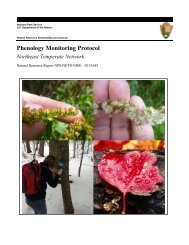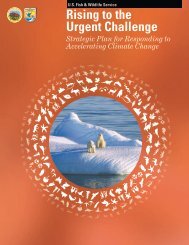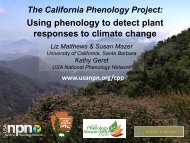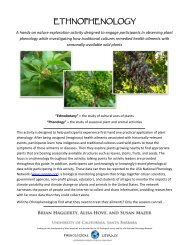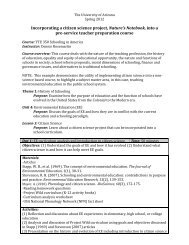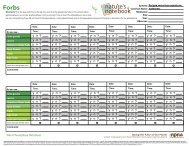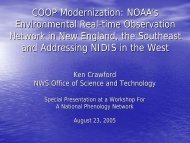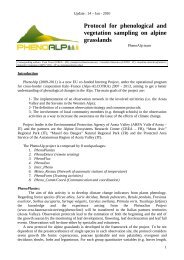The Phenology Handbook - USA National Phenology Network
The Phenology Handbook - USA National Phenology Network
The Phenology Handbook - USA National Phenology Network
You also want an ePaper? Increase the reach of your titles
YUMPU automatically turns print PDFs into web optimized ePapers that Google loves.
Within a given community, what are some additional ways in which one or more species are affected by the<br />
timing of the phenophases of other species?<br />
• Pollinators that eat pollen (e.g., female bees and their offspring) will only have a food source if<br />
they are active during the flowering period of their favored plant species. Reciprocally, flowering<br />
plants that rely on animal pollinators will only produce fruits (and seeds) if they flower when their<br />
pollinators are abundant and searching for them.<br />
• Nectar-eating birds, bees, and ants depend on the flowering time of their “prey”; plants that are<br />
attacked by these “nectar-robbers” will suffer reduced fruit and seed production, while plants<br />
that flower when such “thieves” are rare will enjoy higher reproduction (assuming that their pollinators<br />
are available!).<br />
• Flower- and bud-eating beetles, bugs, moth and butterfly larvae, and other insects depend on the<br />
flowering schedules of their prey. So, not only does the phenology of plants affect their exposure<br />
to nectar-thieves, but it also affects their exposure to flower- and bud-eating species.<br />
• <strong>The</strong> phenology of moth and butterfly larvae not only affect the plants that they eat, but it has<br />
strong effects on the survivorship and reproductive success of the birds that eat them.<br />
• Pest-controlling insects and birds eat agricultural pests that, in turn, can destroy crops. A wellknown<br />
example is the lady bug, a type of beetle that eats aphids, which — if not controlled — will<br />
attack young flowers, stems, and leaves. If pest-controlling animals (lady bugs, in this case) are<br />
not active in synchrony with their prey, an entire season of a crop’s production may fail.<br />
In sum, the phenology of plants influences the abundances of the insects that eat or pollinate them as well as of<br />
the birds and small mammals that depend on them for fruits and seeds. <strong>The</strong> phenology of plant-eating insects<br />
and small mammals, in turn, affects the reproduction of their plant prey. <strong>The</strong> phenology of pollinating insects<br />
affects the reproductive success of the plants that they visit. And, the phenology of insectivorous birds affects<br />
the larvae on which they depend and the plants on which those larvae are found!<br />
<strong>The</strong> answers to the above questions can have important implications both for wild species and for managed<br />
crops. <strong>The</strong> long-term viability of many wild plant populations depends on successful pollination, which can be<br />
limited if plants flower when pollinators are scarce or unavailable. If fruit and seed production are diminished<br />
because of plant-pollinator asynchrony, food availability to frugivorous (fruit-eating) birds and mammals could<br />
be severely reduced. It is easy to imagine how food web dynamics in nature could be altered by asynchrony in<br />
the biological community. This is also true in the case of managed crops, where almost all of the farmed fruits<br />
that humans eat come from pollination services that are provided by insects. <strong>The</strong> synchrony of pollinator availability<br />
and flowering in farmed plants is therefore critical to our ability to produce food.<br />
THE MODERN SCIENCE OF PHENOLOGY<br />
A new era in seasonal studies<br />
Modern phenological studies are thought to have been initiated in Europe in the mid-18th century. Beginning<br />
in 1736, Robert Marsham kept detailed records of “Indications of Spring” on his family estate in Norfolk, Britain<br />
with the goal of improving timber production by learning more about the timing of plant and animal life cycles.<br />
His annual observations included the first occurrences of leafing, flowering and insect emergence. His descendents<br />
maintained these records until 1947, making it one of Europe’s longest phenological monitoring records.<br />
Although he was equipped with only a notebook and a writing instrument, the “modern” aspect of Marsham’s<br />
approach was the systematic nature in which he recorded phenological events for many wild species living in a<br />
single ecosystem (27 phenophases for 20 plants and animals).<br />
12



